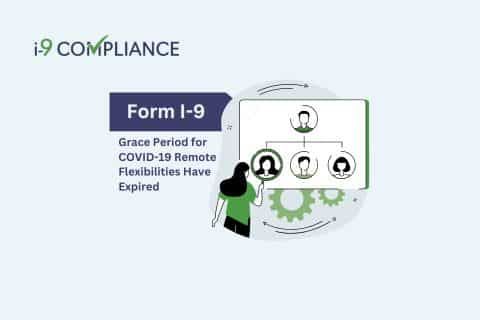Form I-9 Grace Period for COVID-19 Remote Flexibilities Have Expired

September 08, 2023
The temporary remote flexibilities introduced by the Department of Homeland Security (DHS) on March 20, 2020, ended on July 31, 2023. In addition, the grace period for completing the re-inspection of I-9 documentation verified using these flexibilities has officially ended on August 30, 2023.
This period allowed employers to complete a new Form I-9 inspection for employees verified remotely through the temporary flexibilities. However, the DHS indicated that it may not take action against employers that prove good-faith efforts but failed to make the deadline. Employers should quickly update their employment eligibility verifications (Form I-9) despite this reassurance.
Employers must review their employees’ I-9 documents if they filled out the original Form I-9s remotely. However, this requirement applies to remote verifications completed between March 2020 and July 31, 2023. They must physically inspect these forms if they do not qualify for the newly introduced remote alternatives.
Employers may use an authorized representative to complete the inspection or perform the process themselves. Employees must present their I-9 documentation for a physical inspection during the review. Once inspected, the employer or authorized representative should annotate the “Additional Information” field where appropriate (either Section 2 or 3). This field should include “COVID-19,” “documents physically inspected,” the inspection date, and the representative’s initials conducting the review.
Sometimes, the person conducting the re-inspection during the physical review differs from the original remote inspection. The DHS advises the new individual to include their full name and title when noting the inspection date. Otherwise, they can complete a new Section 2 and attach it to the original remotely completed Form I-9.
Employers may encounter cases when the employee presents acceptable documents different from those used during the remote inspection. They have two options in this case: Complete a new Section 2 and attach it to the original Form I-9 or annotate the change in the Additional Information field.
The DHS recommends that employers use the first suggestion. Otherwise, employers must include the following information in the Additional Information field:
- Title of new documentation
- Document number
- The issuer of new documentation
- The expiration date of the documentation, if relevant
- An explanation that the employee presented this new document during the physical inspection
Finally, employers may continue the re-verification as expected when presented with the original, unexpired documentation.
Employers currently enrolled and participating in the E-Verify program may use the DHS’s new remote inspection option. However, they must prove they had good standing with E-Verify. The DHS also specified that employers had to create cases for the employees at the time of the original verification. Companies using this option must follow the steps outlined in the alternative procedure.
Regardless of which procedure employers choose, an electronic I-9 management system with E-Verify integration can help. This system can provide employers with step-by-step guidance through the verification process. It also provides electronic storage and reminders when action is required.
Make re-verification less complicated for your business by automating your employment eligibility verification and ensuring compliance with I-9Compliance.